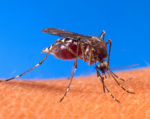Culicidae
| Culicidae | |
|---|---|
| Kingdom | Animalia |
| Phylum | Arthropoda |
| Class | Insecta |
| Order | Diptera |
| Sub-order | Nematocera |
| Super-family | Culicomorpha |
| Family | Culichidae |
Also known as: Mosquitoes
DO NOT CONFUSE WITH: Culicoides midges
Members of the Culicidae family are found across the globe and a attack a wide variety of different species. They are holometabola and have four stages to their life cycle (see below); egg, larva, pupa and adult. The flies are most active at night and largely feed on necatar, only the females take a blood meal in order to produce eggs. The bites from the female blood feed are painful to the host and can occasionally cause allergic hypersensitivity response. Aside from the pain of the bites Culicidae flies are carriers of a number of other pathogens. Viruses such as arbovirus which causes equine encephalitis and rabbit myxomatosis as well as some parasites such as the canine heartworm, Dirofilaria immitis and avian malaria caused by Plasmodium. This transmission of pathogens is the primary health concern attached with Culicidae species and the reason for the requirement to control their levels.
The genus' of greatest veterinary importance are;
- Culex
- Aedes
- Anopheles
Identification
Culicidae flies like all insects have 3 pairs of legs and like all Diptera order flies have only a single set of wings and vestigal set of 'halters'. They are small flies, between 2 and 10mm long with a slender body and legs. They consist of a head, thorax and abdomen and have a forward facing proboscis used for feeding that protrudes from the head. The proboscis of the female is considerably longer than in the male as it is required to take a blood meal. The wings of Culicidae flies are narrow with prominent veins and fringed with scales at the rear margins.
Life Cycle
The life cycle of Culicidae flies is holometabolous meaning that they have a number of distinct morphological states. The initial stages require areas of standing water in which to develop. The life cycle of these flies my take anywhere from two weeks to several months dependent on environmental conditions, principally the temperature.
Eggs
The eggs of Culicidae flies must be laid on areas of standing water such as buckets or ponds. They are laid either singularly or in rafts. Some species of the genera Aedes will lay their eggs on a moist substrate where they mature and await a suitable water level to stimulate hatching.
Larva
The larval stages are aquatic free living stages living close to the surface of standing water and feeding off the algae in the surface layer of the water. They can be seen hanging from the surface but may move deeper into the water if it is disturbed. The larval stage goes through several moults before it pupates.
Pupa
The pupal stage of Culicidae flies is also aquatic and hangs from the surface of standing water. No feeding occurs at this stage which can last from 1 to 7 days.
Adult
The adult fly emerges from the pupa after a number of days and is the only non aquatic stage of the life cycle. Both the male and female are nectar feeders, however in order to provide the nutrients for producing eggs the female must take a blood meal. The initial blood meal matures the females ovaries to begin egg maturation, a further blood meal must be taken for each subsequent clutch of eggs to be matured.
Control
The most effective method of control of these species is to remove suitable locations for eggs to be laid. This is achieved by removing objects that collect water and areas of standing water. Alongside this the use of insecticides is possible but requires several repeat applications. In the future it may be possible to use biological and genetic control methods which are currently under development.
| Culicidae Learning Resources | |
|---|---|
 Search for recent publications via CAB Abstract (CABI log in required) |
Culicidae/mosquito control publications |
| This article has been peer reviewed but is awaiting expert review. If you would like to help with this, please see more information about expert reviewing. |
Error in widget FBRecommend: unable to write file /var/www/wikivet.net/extensions/Widgets/compiled_templates/wrt661e054cb9f983_61843701 Error in widget google+: unable to write file /var/www/wikivet.net/extensions/Widgets/compiled_templates/wrt661e054cbd0620_97557065 Error in widget TwitterTweet: unable to write file /var/www/wikivet.net/extensions/Widgets/compiled_templates/wrt661e054cbff160_66710310
|
| WikiVet® Introduction - Help WikiVet - Report a Problem |
